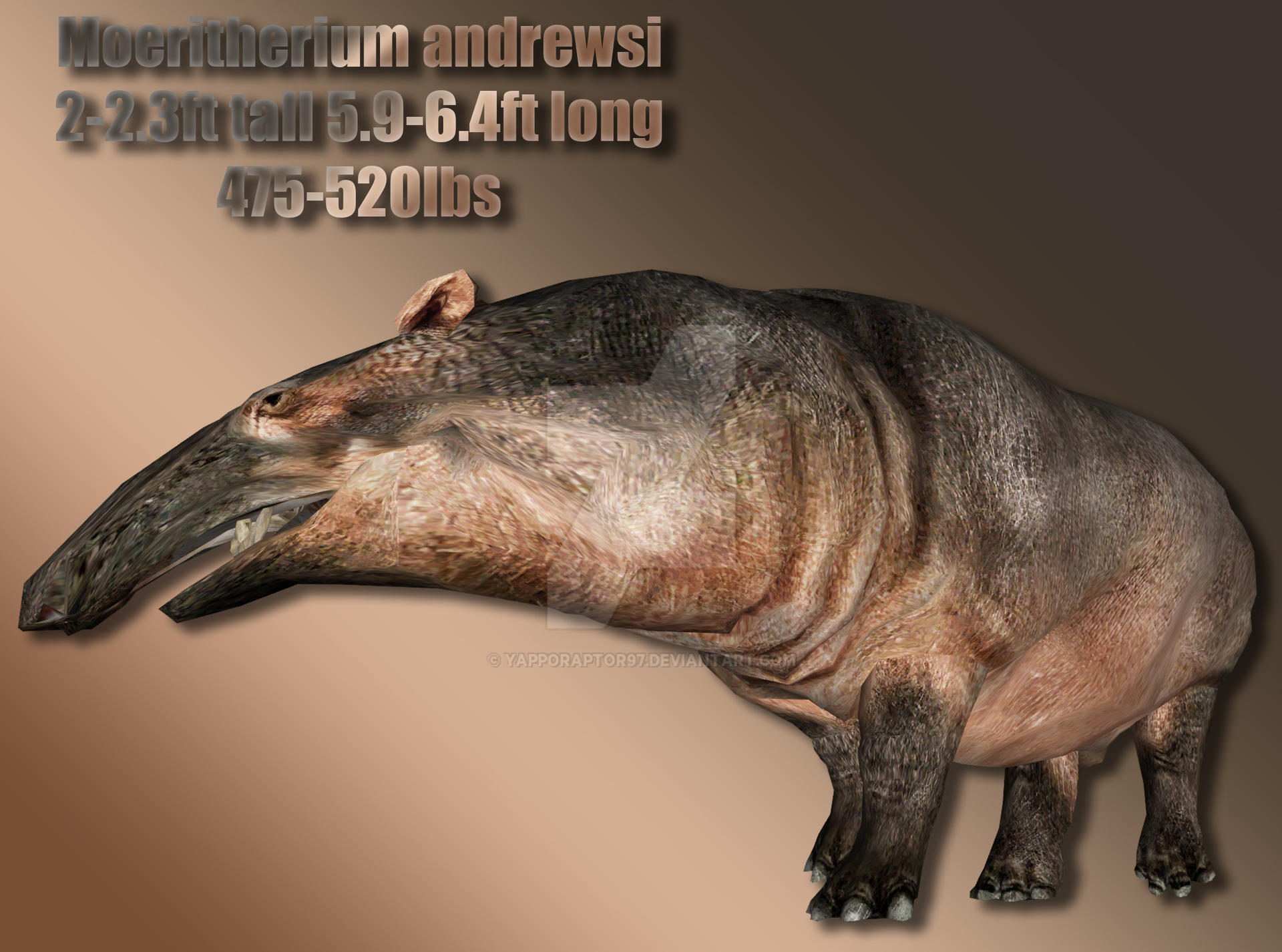 Yapporaptor97 on DeviantArthttps://www.deviantart.com/yapporaptor97/art/Moeritherium-Profile-887590503Yapporaptor97
Yapporaptor97 on DeviantArthttps://www.deviantart.com/yapporaptor97/art/Moeritherium-Profile-887590503Yapporaptor97Deviation Actions
Description
Proboscideans have no shortage of iconic animals. From woolly coats to hoe-tusks, shovel-tusks, and multi-tusked animals. Usually all of them have massive bodies and would eventually evolve to become the most prolific megafaunal mammals of the Cenozoic. However, like all mammals post-KT event after the extinction of the dinosaurs, they started out small. Many different forms rose up and would eventually give rise to the iconic land mammals that walk the planet today. Among the most famous would be Moeritherium.
Fossils of this animal have been dated to around 37-35,000,000 years ago. While by no means large, being around the size of a large tapir or pygmy hippo at around ~500lbs, 2ft tall and 6ft long. And it really resembled the former animal, the tapir and probably lived like one. The proboscidean incisors which in later species would become tusks, more or less resemble the tusks of a hippopotamus, but on a much smaller scale.
The animal was described in 1901, by British paleontologist Charles William Andrews while looking for fossils in South-West Egypt in the Qasr el Sagha Formation. Described the same year it was discovered, he called it: Moeritherium lyonsi. The name is derived from a lake nearby the formation called Lake Moeris, so the name literally means, "Beast from Lake Moeris". Later he would describe the smaller M.gracile and M.trigodon. In 1911, another large species, Moeritherium andrewsi was unearthed in Algeria and described by Max Schlosser. That same year, Schlosser split the animals into two species, M.lyonsi and M.andrewsi. It was named after Charles W. Andrews himself. The most recent discovered, M.chehbeurameuri was also unearthed in Algeria in 2006. As of 2021, all five species of this primitive proboscidean are considered to be valid.
As previously mentioned, to some extent, the behavior of this animal was probably reminiscent of tapirs. The short legs and smaller body were very similar to tapirs. However, it should be noted that a Moeritherium's "trunk" is not as pronounced as a lot of proboscideans of this period, nor is it even as pronounced as some Tapirs. While probably did have some nasal muscle movement, it probably was not as pronounced as some trunked animals.
The habitat of this animal has been extrapolated to be a fluvio-marine formation where various river estuaries flowed inland. Brackish and Swampy habitats would have been the ideal habitat for these animals. The teeth were not as pronounced as more derived and larger proboscideans suggesting it ate softer vegetation. The most obvious candidate would be water vegetation within these river tributaries.
It cannot be determined if the matriarchal structure seen in modern and some prehistoric elephants had developed. However, even if it did, being in a herd would not have defended these beasts from predation. However, the predators would not come from the land. Being close to the coastline, proto-whales like the giant Basilosaurus and sharks like various species of Otodus sharks lived in these waters.
From the 2001 BBC Series Walking With Beasts, a Moeritherium was depicted as being stranded on an isolated beach while the tide rose. A giant female Basilosaurus stalked the waters around the sandbar before it tried to snatch the animal, ultimately failing. While there is no evidence of predation from bones on Moeritherium remains by Basilosaurus, recent studies of their biology indicate that these giant whales were more likely to have been predators of shallower regions of the oceans and tidal inlets.
Not that dissimilar from the scene portrayed in the BBC TV series. So, while not confirmed, it is possible that these giant whales occasionally could have snagged a Moeritherium while patrolling the various inlets and mangrove forests of what is today Northern Africa.
The giant sharks and whales were not the only predators from the region. One of the largest snakes, Gigantophis has also been found in the varying formations that Moeritherium inhabited. This giant constrictor snake could have easily hunted Moeritherium given that in the modern-day Amazon, Anacondas have been documented killing Tapirs which are very similar in size to Moeritherium.
While it was a basal proboscidean, many paleontologists believe that this animal was not a direct descendant to modern-day proboscideans. Breaking off from the family that would eventually give rise to modern elephants probably between 45-40,000,000 years ago. Animals like Palaeomastodon and Phiomia would eventually give rise to the more recognizable forms. Animals like Moeritherium was an animal that was essentially an evolutionary dead-end.
When one looks at the morphology of this animal it makes sense. Creatures like Palaeomastodon had more erect legs and a more compressed body, compared to the elongated, rotund, squat body that belonged to Moeritherium.
The extinction of this animal is largely believed to have been climate change. As far as paleontologists know, this species of proboscidean existed in what is now Northern Africa, so its range was not as widespread as other more derived proboscideans. As the climate changed, the fluvial habitats changed drastically, and they couldn't cope with the changing climate. By 35,000,000 years, these animals would go extinct. Proboscideans would persist, but these strange tapir-like proboscideans would die out.
___________________________________________________________________________________________
Another Cenozoic animal, and I just found this while browsing through the library. Still remember seeing this guy from WWB, and it was such a bizarre creature.
Will this be in PMP? No. I couldn't really build an environment around this guy.
As far as the model goes, I got it from ZT2 Thailand, and this beast was probably based off the one from WWB, which the recreation was pretty good in how they depicted it. A brackish plant grazer. This model is pretty good, with some minor distortions in the texture, but it's pretty good.
Model and Skin by ZT2 Thailand:
Moeritherium (Zoo Tycoon 2 Thailand) | ZT2 Download Library Wiki | Fandom
One horrifying tapir.